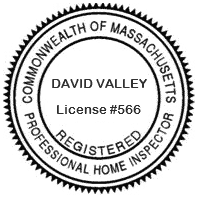Massachusetts Home Inspections YOUR INVESTMENT IS MY CONCERN

Glossary - A thru H
Glossary of Common Building Terms
A/C - An abbreviation for air conditioner or air conditioning.
A/C Condenser - The outside fan unit of the Air Conditioning system. It removes the heat from the freon gas and "turns" the gas back into a liquid and pumps the liquid back to the coil in the furnace.
Aerator - The round screened screw-on tip of a sink spout. It mixes water and air for a smooth flow.
Aggregate - A mixture of sand and stone and a major component of concrete.
Air space - The area between insulation facing and interior of exterior wall coverings. Normally a 1" air gap.
Allowance(s) - A sum of money set aside in the construction contract for items which have not been selected and specified in the construction contract. For example, selection of tile as a flooring may require an allowance for an underlayment material, or an electrical allowance which sets aside an amount of money to be spent on electrical fixtures.
Anchor bolts - Bolts to secure a wooden sill plate to concrete , or masonry floor or wall.
Annual Percentage Rate (APR) - Annual cost of credit over the life of a loan, including interest, service charges, points, loan fees, mortgage insurance, and other items.
Appraisal - An expert valuation of property.
Apron - A trim board that is installed beneath a window sill.
Area wells (window wells) - Corrugated metal or concrete barrier walls installed around a basement window to hold back the earth.
Assessment - A tax levied on a property, or a value placed on the worth of a property.
Astragal - A molding, attached to one of a pair of swinging double doors, against which the other door strikes.
Attic access - An opening that is placed in the drywalled ceiling of a home providing access to the attic.
Attic Ventilators - In houses, screened openings provided to ventilate an attic space.
Backfill - The replacement of excavated earth into a trench around or against a basement /crawl space foundationwall.
Backing - Frame lumber installed between the wall studs to give additional support for drywall or an interior trim related item, such as handrail brackets, cabinets, and towel bars. In this way, items are screwed and mounted into solid wood rather than weak drywall that may allow the item to break loose from the wall. Carpet backing holds the pile fabric in place.
Backout - Work the framing contractor does after the mechanical subcontractors (Heating-Plumbing-Electrical) finish their phase of work at the Rough (before insulation) stage to get the home ready for a municipal frame inspection. Generally, the framing contractor repairs anything disturbed by others and completes all framing necessary to pass a Rough Frame Inspection.
Ballast - A transformer that steps up the voltage in a florescent lamp.
Balloon - A loan that has a series of monthly payments with the remaining balance due in a large lump sum payment at the end.
Balloon framed wall - Framed walls (generally over 10' tall) that run the entire vertical length from the floor sill plate to the roof. This is done to eliminate the need for a gable end truss.
Balusters - Vertical members in a railing used between a top rail and bottom rail or the stair treads. Sometimes referred to as 'pickets' or 'spindles'.
Balustrade - The rail, posts and vertical balusters along the edge of a stairway or elevated walkway.
Barge - Horizontal beam rafter that supports shorter rafters.
Barge board - A decorative board covering the projecting rafter (fly rafter) of the gable end. At the cornice, this member is a fascia board.
Base or baseboard - A trim board placed against the wall around the room next to the floor.
Basement window inserts - The window frame and glass unit that is installed in the window buck.
Base shoe - Molding used next to the floor on interior base board. Sometimes called a carpet strip.
Bat - A half-brick.
Batt - A section of fiber-glass or rock-wool insulation measuring 15 or 23 inches wide by four to eight feet long and various thickness'; Sometimes "faced" (meaning to have a paper covering on one side) or "unfaced" (without paper).
Batten - Narrow strips of wood used to cover joints or as decorative vertical members over plywood or wide boards.
Bay window - Any window space projecting outward from the walls of a building, either square or polygonal in plan.
Beam - A structural member transversely supporting a load. A structural member carrying building loads (weight) from one support to another. Sometimes called a "girder".
Bearing partition - A partition that supports any vertical load in addition to its own weight.
Bearing point - A point where a bearing or structural weight is concentrated and transferred to the foundation.
Bearing wall - A wall that supports any vertical load in addition to its own weight.
Bearing header - (a) A beam placed perpendicular to joists and to which joists are nailed in framing for a chimney, stairway, or other opening. (b) A wood lintel. (c) The horizontal structural member over an opening (for example over a door or window).
Bedrock - A subsurface layer of earth that is suitable to support a structure.
Bifold door - Doors that are hinged in the middle for opening in a smaller area than standard swing doors. Often used for closet doors.
Binder - A receipt for a deposit to secure the right to purchase a home at an agreed terms by a buyer and seller.
Bipass doors - Doors that slide by each other and commonly used as closet doors.
Blankets - Fiber-glass or rock-wool insulation that comes in long rolls 15 or 23 inches wide.
Blocked (door blocking) - Wood shims used between the door frame and the vertical structural wall framing members.
Blocked (rafters) - Short "2 by 4's" used to keep rafters from twisting, and installed at the ends and at mid-span.
Blocking - Small wood pieces to brace framing members or to provide a nailing base for gypsum board or paneling.
Block out - To install a box or barrier within a foundation wall to prevent the concrete from entering an area. For example, foundation walls are sometimes "blocked" in order for mechanical pipes to pass through the wall, to install a crawl space door, and to depress the concrete at a garage door location.
Blow insulation - Fiber insulation in loose form and used to insulate attics and existing walls where framing members are not exposed.
Blue print(s) - A type of copying method often used for architectural drawings. Usually used to describe the drawing of a structure which is prepared by an architect or designer for the purpose of design and planning, estimating, securing permits and actual construction.
Blue stake - Another phrase for Utility Notification. This is when a utility company (telephone, gas, electric, cable TV, sewer and water, etc) comes to the job site and locates and spray paints the ground and/or installs little flags to show where their service is located underground.
Blow insulation - Fiber insulation in loose form and used to insulate attics and existing walls where framing members are not exposed.
Board foot - A unit of measure for lumber equal to 1 inch thick by 12 inches wide by 12 inches long. Examples: 1" x 12" x 16' = 16 board feet, 2" x 12" x 16' = 32 board feet.
Bond or bonding - An amount of money (usually $5,000-$10,000) which must be on deposit with a governmental agency in order to secure a contractor's license. The bond may be used to pay for the unpaid bills or disputed work of the contractor. Not to be confused with a 'performance bond'. Such bonds are rarely used in residential construction, they are an insurance policy which guarantees proper completion of a project.
Boom - A truck used to hoist heavy material up and into place. To put trusses on a home or to set a heavy beam into place.
Bottom chord - The lower or bottom horizontal member of a truss.
Bottom plate - The "2 by 4's or 6's" that lay on the subfloor upon which the vertical studs are installed. Also called the 'sole plate'.
Brace - An inclined piece of framing lumber applied to wall or floor to strengthen the structure. Often used on walls as temporary bracing until framing has been completed.
Breaker panel - The electrical box that distributes electric power entering the home to each branch circuit (each plug and switch) and composed of circuit breakers.
Brick ledge - Part of the foundation wall where brick (veneer) will rest.
Brick lintel - The metal angle iron that brick rests on, especially above a window, door, or other opening.
Brick mold - Trim used around an exterior door jamb that siding butts to .
Brick tie - A small, corrugated metal strip @ 1" X 6"- 8" long nailed to wall sheeting or studs. They are inserted into the grout mortar joint of the veneer brick, and holds the veneer wall to the sheeted wall behind it.
Brick veneer - A vertical facing of brick laid against and fastened to sheathing of a framed wall or tile wall construction.
Bridging - Small wood or metal members that are inserted in a diagonal position between the floor joists or rafters at mid-span for the purpose of bracing the joists/rafters; spreading the load.
Buck - Often used in reference to rough frame opening members. Door bucks used in reference to metal door frame. See Window Bucks.
Builder's Risk Insurance - Insurance coverage on a construction project during construction, including extended coverage that may be added for the contract for the customer's protections.
Building codes - Community ordinances governing the manner in which a home may be constructed or modified.
Building insurance - Insurance covering the structure of the building.
Building paper - A general term for papers, felts, and similar sheet materials used in buildings without reference to their properties or uses. Generally comes in long rolls.
Built-up roof - A roofing composed of three to five layers of asphalt felt laminated with coal tar, pitch, or asphalt. The top is finished with crushed slag or gravel. Generally used on flat or low-pitched roofs.
Bull nose (drywall) - Rounded drywall corners.
Bundle - A package of shingles. Normally, there are 3 bundles per square and 27 shingles per bundle.
Butt edge - The lower edge of the shingle tabs.
Butt hinge - The most common type. One leaf attaches to the door's edge, the other to its jamb.
Butt joint - The junction where the ends of two timbers meet, and also where sheets of drywall meet on the 4 foot edge. To place materials end-to-end or end-to-edge without overlapping.
By pass doors - Doors that slide by each other and commonly used as closet doors.
CO - An abbreviation for "Certificate of Occupancy". This certificate is issued by the local municipality and is required before anyone can occupy and live within the home. It is issued only after the local municipality has made all inspections and all monies and fees have been paid.
Caisson - A 10" or 12" diameter hole drilled into the earth and embedded into bedrock 3 - 4 feet. The structural support for a type of foundation wall, porch, patio, monopost, or other structure. Two or more "sticks" of reinforcing bars (rebar) are inserted into and run the full length of the hole and concrete is poured into the caisson hole.
Cantilever - An overhang. Where one floor extends beyond and over a foundation wall. For example at a fireplace location or bay window cantilever. Normally, not extending over 2 feet.
Cap - The upper member of a column, pilaster, door cornice, molding, or fireplace.
Cap flashing - The portion of the flashing attached to a vertical surface to prevent water from migrating behind the base flashing.
Casement - Frames of wood or metal enclosing part (or all) of a window sash. May be opened by means of hinges affixed to the vertical edges.
Casement Window - A window with hinges on one of the vertical sides and swings open like a normal door.
Casing - Molding of various widths and thicknesses used to trim door and window openings at the jambs.
Caulking - (1) A flexible material used to seal a gap between two surfaces e.g. between pieces of siding or the corners in tub walls. (2) To fill a joint with mastic or asphalt plastic cement to prevent leaks.
CCA (Chromated Copper Arsenate) - A pesticide that is forced into wood under high pressure to protect it from termites, other wood boring insects, and decay caused by fungus.
Ceiling joist - One of a series of parallel framing members used to support ceiling loads and supported in turn by larger beams, girders or bearing walls. Also called roof joists.
Cement - The gray powder that is the "glue" in concrete. Portland cement. Also, any adhesive.
Ceramic tile - A man-made or machine-made clay tile used to finish a floor or wall. Generally used in bathtub and shower enclosures and on counter tops.
CFM (cubic feet per minute) - A rating that expresses the amount of air a blower or fan can move. The volume of air (measured in cubic feet) that can pass through an opening in one minute.
Chair rail - Interior trim material installed about 3-4 feet up the wall, horizontally.
Chase - A framed enclosed space around a flue pipe or a channel in a wall, or through a ceiling for something to lie in or pass through.
Chink - To install fiberglass insulation around all exterior door and window frames, wall corners, and small gaps in the exterior wall.
Chip Board - A manufactured wood panel made out of 1" - 2" wood chips and glue. Often used as a substitute for plywood in the exterior wall and roof sheathing. Also called OSB (Oriented Strand Board) or wafer board.
Circuit - The path of electrical flow from a power source through an outlet and back to ground.
Circuit Breaker - A device which looks like a switch and is usually located inside the electrical breaker panel or circuit breaker box. It is designed to (1) shut of the power to portions or all of the house and (2) to limit the amount of power flowing through a circuit (measured in amperes). 110 volt household circuits require a fuse or circuit breaker with a rating of 15 or a maximum of 20 amps. 220 volt circuits may be designed for higher amperage loads. Example... A hot water heater may be designed for a 30 amp load and would therefore need a 30 amp fuse or breaker.
Class "A" - Optimum fire rating issued by Underwriter's Laboratories on roofing. The building codes in some areas require this type of roofing for fire safety.
Class "C" - Minimum fire rating issued by the Underwriters' Laboratories for roofing materials.
Clean out - An opening providing access to a drain line. Closed with a threaded plug.
Clip ties - Sharp, cut metal wires that protrude out of a concrete foundation wall (that at one time held the foundation form panels in place).
Cold air return - The ductwork (and related grills) that carries room air back to the furnace for re-heating.
Collar - Preformed flange placed over a vent pipe to seal the roofing above the vent pipe opening. Also called a vent sleeve.
Collar beam - Nominal 1 - or 2 -inch -thick members connecting opposite roof rafters. They serve to stiffen the roof structure.
Column - A vertical structural compression member which supports loads.
Combustion air - The duct work installed to bring fresh, outside air to the furnace and/or hot water heater. Normally 2 separate supplies of air are brought in: One is high and one is low.
Combustion chamber - The part of a boiler, furnace or woodstove where the burn occurs; normally lined with firebrick or molded or sprayed insulation.
Compression web - A member of a truss system which connects the bottom and top chords and which provides downward support.
Compressor - A mechanical device that pressurizes a gas in order to turn it into a liquid, thereby allowing heat to be removed or added. A compressor is the main component of conventional heat pumps and air conditioners. In an air conditioning system, the compressor normally sits outside and has a large fan (to remove heat).
Concrete - The mixture of Portland cement, sand, gravel, and water. Used to make garage and basement floors, sidewalks, patios, foundation walls, etc. It is commonly reinforced with steel rods (rebar) or wire screening (mesh).
Concrete block - A hollow concrete 'brick' often 8" x 8" x 16" in size.
Concrete board - A panel made out of concrete and fiberglass usually used as a tile backing material.
Condensate line - The copper pipe that runs from the outside air conditioning condenser to the inside furnace ( where the a/c coil is located).
Condensation - Beads or drops of water (and frequently frost in extremely cold weather) that accumulate on the inside of the exterior covering of a building. Use of louvers or attic ventilators will reduce moisture condensation in attics. A vapor barrier under the gypsum lath or dry wall on exposed walls will reduce condensation.
Condensing unit - The outdoor component of a cooling system. It includes a compressor and condensing coil designed to give off heat.
Conditions, Convenants, and Restrictions (CC and Rs) - The standards that define how a property may be used and the protections the developer makes for the benefit of all owners in a subdivision.
Conduction - The direct transfer of heat energy through a material.
Conductivity - The rate at which heat is transmitted through a material.
Conduit, electrical - A pipe, usually metal, in which wire is installed.
Construction drywall - A type of construction in which the interior wall finish is applied in a dry condition, generally in the form of sheet materials or wood paneling as contrasted to plaster.
Construction, frame - A type of construction in which the structural components are wood or depend upon a wood frame for support.
Continuity tester - A device that tells whether a circuit is capable of carrying electricity.
Control joint - Tooled, straight grooves made on concrete floors to "control" where the concrete should crack.
Convection - Currents created by heating air, which then rises and pulls cooler air behind it. Also see radiation.
Conventional loan - A mortgage loan not insured by a government agency (such as FHA or VA).
Convertibility - The ability to change a loan from an adjustable rate schedule to a fixed rate schedule.
Cooling load - The amount of cooling required to keep a building at a specified temperature during the summer, usually 78? F, regardless of outside temperature.
Coped - Removing the top and bottom flange of the end(s) of a metal I -beam. This is done to permit it to fit within, and bolted to, the web of another I -beam in a "T" arrangement.
Coped joint - Cutting and fitting woodwork to an irregular surface.
Corbel - The triangular, decorative and supporting member that holds a mantel or horizontal shelf.
Corner bead - A strip of formed sheet metal placed on outside corners of drywall before applying drywall 'mud'.
Corner boards - Used as trim for the external corners of a house or other frame structure against which the ends of the siding are finished.
Corner braces - Diagonal braces at the corners of the framed structure designed to stiffen and strengthen the wall.
Cornice - Overhang of a pitched roof , usually consisting of a fascia board, a soffit and appropriate trim moldings.
Counter flashing - A metal flashing usually used on chimneys at the roofline to cover shingle flashing and used to prevent moisture entry.
Counterfort - A foundation wall section that strengthens (and generally perpendicular to) a long section of foundation wall.
Course - A row of shingles or roll roofing running the length of the roof. Parallel layers of building materials such as bricks, or siding laid up horizontally.
Cove molding - A molding with a concave face used as trim or to finish interior corners.
Crawl space - A shallow space below the living quarters of a house, normally enclosed by the foundation wall and having a dirt floor.
Credit rating - A report ordered by a lender from a credit agency to determine a borrower's credit habits.
Cricket - A second roof built on top of the primary roof to increase the slope of the roof or valley. A saddle-shaped, peaked construction connecting a sloping roof with a chimney. Designed to encourage water drainage away from the chimney joint.
Cripple - Short vertical "2 by 4's or 6's" frame lumber installed above a window or door.
Cross bridging - Diagonal bracing between adjacent floor joists, placed near the center of the joist span to prevent joists from twisting.
Cross Tee - Short metal "T" beam used in suspended ceiling systems to bridge the spaces between the main beams.
Crown molding - A molding used on cornice or wherever an interior angle is to be covered, especially at the roof and wall corner.
Culvert - Round, corrugated drain pipe (normally 15" or 18" in diameter) that is installed beneath a driveway and parallel to and near the street.
Cupping - A type of warping that causes boards to curl up at their edges.
Curb - The short elevation of an exterior wall above the deck of a roof. Normally a 2 by 6 box (on the roof) on which a skylight is attached.
Curb stop - Normally a cast iron pipe with a lid (@ 5" in diameter) that is placed vertically into the ground, situated near the water tap in the yard, and where a water cut-off valve to the home is located (underground). A long pole with a special end is inserted into the curb stop to turn off/on the water.
Cut-in brace - Nominal 2 -inch -thick members, usually 2 by 4's, cut in between each stud diagonally.
Dado - A groove cut into a board or panel intended to receive the edge of a connecting board or panel.
Damper - A metal "door" placed within the fireplace chimney. Normally closed when the fireplace is not in use.
Dampproofing - The black, tar like waterproofing material applied to the exterior of a foundation wall.
Daylight - The end of a pipe (the terminal end) that is not attached to anything.
Dead bolt - An exterior security lock installed on exterior entry doors that can be activated only with a key or thumb-turn. Unlike a latch, which has a beveled tongue, dead bolts have square ends.
Dead light - The fixed, non -operable window section of a window unit.
Deck, decked - To install the plywood or wafer board sheeting on the floor joists, rafters, or trusses.
Dedicated circuit - An electrical circuit that serves only one appliance (ie, dishwasher) or a series of electric heaters or smoke detectors.
Default - Breach of a mortgage contract (not making the required payments).
De-humidistat - A control mechanism used to operate a mechanical ventilation system based upon the relative humidity in the home.
Delamination - Separation of the plies in a panel due to failure of the adhesive. Usually caused by excessive moisture.
Disconnect - A large (generally 20 Amp) electrical ON -OFF switch.
Discount rate - A mortgage interest rate that is lower than the current rate for a certain period of time.
Doorjamb, interior - The surrounding case into which and out of which a door closes and opens. It consists of two upright pieces, called side jambs, and a horizontal head jamb. These 3 jambs have the "door stop" installed on them.
Door operator - An automatic garage door opener.
Door stop - The wooden style that the door slab will rest upon when it's in a closed position.
Dormer - An opening in a sloping roof, the framing of which projects out to form a vertical wall suitable for windows or other openings.
Double glass - Window or door in which two panes of glass are used with a sealed air space between. Also known as Insulating Glass.
Double hung window - A window with two vertically sliding sashes, both of which can move up and down.
Down payment - The difference between the sales price and the mortgage amount. A downpayment is usually paid at closing.
Downspout - A pipe, usually of metal, for carrying rainwater down from the roof's horizontal gutters.
Drain tile - A perforated, corrugated plastic pipe laid at the bottom of the foundation wall and used to drain excess water away from the foundation. It prevents ground water from seeping through the foundation wall. Sometimes called perimeter drain.
Draw - The amount of progress billings on a contract that is currently available to a contractor under a contract with a fixed payment schedule.
Drip - (a) A member of a cornice or other horizontal exterior finish course that has a projection beyond the other parts for throwing off water. (b) A groove in the underside of a sill or drip cap to cause water to drop off on the outer edge instead of drawing back and running down the face of the building.
Drip cap - A molding or metal flashing placed on the exterior topside of a door or window frame to cause water to drip beyond the outside of the frame.
Dry-in - To install the black roofing felt (tar paper) on the roof.
Drywall (or Gypsum Wallboard (GWB), Sheet rock or Plasterboard) - Wall board or gypsum - A manufactured panel made out of gypsum plaster and encased in a thin cardboard. Usually 1/2" thick and 4' x 8' or 4' x 12' in size. The panels are nailed or screwed onto the framing and the joints are taped and covered with a 'joint compound'. "Green board" type drywall has a greater resistance to moisture than regular (white) plasterboard and is used in bathrooms and other "wet areas".
Ducts - The heating system. Usually round or rectangular metal pipes installed for distributing warm (or cold) air from the furnace to rooms in the home. Also a tunnel made of galvanized metal or rigid fiberglass, which carries air from the heater or ventilation opening to the rooms in a building.
Due-on-sale - A clause in a mortgage contract requiring the borrower to pay the entire outstanding balance upon sale or transfer of the property.
Dura board, dura rock - A panel made out of concrete and fiberglass usually used as a ceramic tile backing material. Commonly used on bathtub decks. Sometimes called Wonder board.
DWV (drain -waste -vent) - The section of a plumbing system that carries water and sewer gases out of a home.
Earthquake Strap - A metal strap used to secure gas hot water heaters to the framing or foundation of a house. Intended to reduce the chances of having the water heater fall over in an earthquake and causing a gas leak.
Easement - A formal contract which allows a party to use another party's property for a specific purpose. Example...A sewer easement might allow one party to run a sewer line through a neighbors property.
Eaves - The horizontal exterior roof overhang.
Egress - A means of exiting the home. An egress window is required in every bedroom and basement. Normally a 4' X 4' window is the minimum size required.
Elbow (ell) - A plumbing or electrical fitting that lets you change directions in runs of pipe or conduit.
Electric lateral - The trench or area in the yard where the electric service line (from a transformer or pedestal) is located, or the work of installing the electric service to a home.
Electric resistance coils - Metal wires that heat up when electric current passes through them and are used in baseboard heaters and electric water heaters.
Electrical entrance package - The entry point of the electrical power including: (1) the 'strike' or location where the overhead or underground electrical lines connect to the house, (2) The meter which measures how much power is used and (3) The 'panel' or 'circuit breaker box ' (or 'fuse box') where the power can be shut off and where overload devices such a fuses or circuit breakers and located.
Electrical Rough - Work performed by the Electrical Contractor after the plumber and heating contractor are complete with their phase of work. Normally all electrical wires, and outlet, switch, and fixture boxes are installed (before insulation).
Electrical Trim - Work performed by the electrical contractor when the house is nearing completion. The electrician installs all plugs, switches, light fixtures, smoke detectors, appliance "pig tails", bath ventilation fans, wires the furnace, and "makes up" the electric house panel. The electrician does all work necessary to get the home ready for and to pass the municipal electrical final inspection.
Elevation sheet - The page on the blue prints that depicts the house or room as if a vertical plane were passed through the structure.
Equity - The "valuation" that you own in your home. Example...the property value less the mortgage loan outstanding.
Escrow - The handling of funds or documents by a third party on behalf of the buyer and/or seller.
Estimate - The amount of labor, materials, and other costs that a contractor anticipates for a project as summarized in the contractor's bid proposal for the project.
Escutcheon - An ornamental plate that fits around a pipe extending through a wall or floor to hide the cut out hole.
Estimating - The process of calculating the cost of a project. This can be a formal and exact process or a quick and imprecise process.
Evaporator coil - The part of a cooling system that absorbs heat from air in your home. Also see Condensing unit.
Expansion joint - Fibrous material (@1/2" thick) installed in and around a concrete slab to permit it to move up and down (seasonally) along the non -moving foundation wall.
Expansive soils - Earth that swells and contracts depending on the amount of water that is present. ("Betonite" is an expansive soil).
Exposed aggregate finish - A method of finishing concrete which washes the cement/sand mixture off the top layer of the aggregate - usually gravel. Often used in driveways, patios and other exterior surfaces.
Extras - Additional work requested of a contractor, not included in the original plan, which will be billed separately and will not alter the original contract amount, but increase the cost of building the home.
FHA strap - Metal straps that are used to repair a bearing wall "cut-out", and to "tie together" wall corners, splices, and bearing headers. Also, they are used to hang stairs and landings to bearing headers.
Face nail - To install nails into the vertical face of a bearing header or beam.
Faced concrete - To finish the front and all vertical sides of a concrete porch, step(s), or patio. Normally the "face" is broom finished.
Facing brick - The brick used and exposed on the outside of a wall. Usually these have a finished texture.
Fascia - Horizontal boards attached to rafter/truss ends at the eaves and along gables. Roof drain gutters are attached to the fascia.
Felt or Tar paper - Installed under the roof shingles. Normally 15 lb. or 30 lb.
Ferrule - Metal tubes used to keep roof gutters "open". Long nails (ferrule spikes) are driven through these tubes and hold the gutters in place along the fascia of the home.
Field measure - To take measurements (cabinets, countertops, stairs, shower doors, etc.) in the home itself instead of using the blueprints.
Finger joint - A manufacturing process of interlocking two shorter pieces of wood end to end to create a longer piece of dimensional lumber or molding. Often used in jambs and casings and are normally painted (instead of stained).
Fire block - Short horizontal members sometimes nailed between studs, usually about halfway up a wall. See also 'Fire stop'.
Fire brick - Brick made of refractory ceramic material which will resist high temperatures. Used in a fireplace and boiler.
Fireplace chase flashing pan - A large sheet of metal that is installed around and perpendicular to the fireplace flue pipe. It's purpose is to confine and limit the spread of fire and smoke to a small area.
Fire -resistive or Fire rated - Applies to materials that are not combustible in the temperatures of ordinary fires and will withstand such fires for at least 1 hour. Drywall used in the garage and party walls are to be fire rated, 5/8", Type X.
Fire retardant chemical - A chemical or preparation of chemicals used to reduce the flammability of a material or to retard the spread of flame.
Fire stop - A solid, tight closure of a concealed space, placed to prevent the spread of fire and smoke through such a space. In a frame wall, this will usually consist of 2 by 4 cross blocking between studs. Work performed to slow the spread of fire and smoke in the walls and ceiling (behind the drywall). Includes stuffing wire holes in the top and bottom plates with insulation, and installing blocks of wood between the wall studs at the drop soffit line. This is integral to passing a Rough Frame inspection. See also "Fire block".
Fishplate (gusset) - A wood or plywood piece used to fasten the ends of two members together at a butt joint with nails or bolts. Sometimes used at the junction of opposite rafters near the ridge line. Sometimes called a gang nail plate.
Fish tape - A long strip of spring steel used for fishing cables and for pulling wires through conduit.
Flagstone (flagging or flags) - Flat stones (1 to 4 inches thick) used for walks, steps, floors, and vertical veneer (in lieu of brick).
Flakeboard - A manufactured wood panel made out of 1" - 2" wood chips and glue. Often used as a substitute for plywood in the exterior wall and roof sheathing. Also called OSB or wafer board.
Flame retention burner - An oil burner, designed to hold the flame near the nozzle surface. Generally the most efficient type for residential use.
Flashing - Sheet metal or other material used in roof and wall construction to protect a building from water seepage.
Flat mold - Thin wood strips installed over the butt seam of cabinet skins.
Flat paint - An interior paint that contains a high proportion of pigment and dries to a flat or lusterless finish.
Flatwork - Common word for concrete floors, driveways, basements, and sidewalks.
Floating - The next -to -last stage in concrete work, when you smooth off the job and bring water to the surface by using a hand float or bull float.
Floating wall - A non -bearing wall built on a concrete floor. It is constructed so that the bottom two horizontal plates can compress or pull apart if the concrete floor moves up or down. Normally built on basements and garage slabs.
Fluorescent lighting - A fluorescent lamp is a gas -filled glass tube with a phosphur coating on the inside. Gas inside the tube is ionized by electricity which causes the phosphur coating to glow. Normally with two pins that extend from each end.
Flue - Large pipe through which fumes escape from a gas water heater, furnace, or fireplace. Normally these flue pipes are double walled, galvanized sheet metal pipe and sometimes referred to as a "B Vent". Fireplace flue pipes are normally triple walled. In addition, nothing combustible shall be within one inch from the flue pipe.
Flue collar - Round metal ring which fits around the heat flue pipe after the pipe passes out of the roof.
Flue damper - An automatic door located in the flue that closes it off when the burner turns off; purpose is to reduce heat loss up the flue from the still -warm furnace or boiler.
Flue lining - 2 -foot lengths, fire clay or terra -cotta pipe (round or square) and usually madein all ordinary flue sizes. Used for the inner lining of chimneys with the brick or masonry work done around the outside. Flue linings in chimneys runs from one foot below the flue connection to the top of the chimney.
Fly rafters - End rafters of the gable overhang supported by roof sheathing and lookouts.
Footer, footing - Continuous 8" or 10" thick concrete pad installed before and supports the foundation wall or monopost.
Forced air heating - A common form of heating with natural gas, propane, oil or electricity as a fuel. Air is heated in the furnace and distributed through a set of metal ducts to various areas of the house.
Form - Temporary structure erected to contain concrete during placing and initial hardening.
Foundation - The supporting portion of a structure below the first floor construction, or below grade, including the footings.
Foundation ties - Metal wires that hold the foundation wall panels and rebar in place during the concrete pour.
Foundation waterproofing - High -quality below -grade moisture protection. Used for below-grade exterior concrete and masonry wall damp-proofing to seal out moisture and prevent corrosion. Normally looks like black tar.
Frame Inspection - The act of inspecting the home's structural integrity and it's complianceto local municipal codes.
Framer -The carpenter contractor that installs the lumber and erects the frame, flooring system, interior walls, backing, trusses, rafters, decking, installs all beams, stairs, soffits and all work related to the wood structure of the home. The framer builds the home according to the blueprints and must comply with local building codes and regulations.
Framing - Lumber used for the structural members of a building, such as studs, joists, and rafters.
Frieze - In house construction a horizontal member connecting the top of the siding with the soffit of the cornice.
Frost lid - Round metal lid that is installed on a water meter pit.
Frost line - The depth of frost penetration in soil and/or the depth at which the earth will freeze and swell. This depth varies in different parts of the country.
Furring strips - Strips of wood, often 1 X 2 and used to shim out and provide a level fastening surface for a wall or ceiling.
Fuse - A device often found in older homes designed to prevent overloads in electrical lines. This protects against fire. See also "Circuit breakers".
G F C I, or G F I - Ground Fault Circuit Interrupter - an ultra sensitive plug designed to shut off all electric current. These safety receptacles are usually installed in locations that are within 6 feet of water. Typical locations include... bathrooms, kitchens, exterior waterproof outlets, garage outlets, and "wet areas". Has a small reset button on the receptacle face.
Gable - The end, upper, triangular area of a home, beneath the roof.
Gang nail plate - A steel plate attached to both sides at each joint of a truss. Sometimes called a fishplate or gussett.
Gate valve - A valve that lets you completely stop?but not modulate?the flow within a pipe.
General Contractor - A contractor who enters into a contract with the owner of a project for the construction of the project and who takes full responsibility for its completion, although the contractor may enter into subcontracts with others for the performance of specific parts or phases of the project.
Gas lateral - The trench or area in the yard where the gas line service is located, or the work of installing the gas service to a home.
Girder - A large or principal beam of wood or steel used to support concentrated loads at isolated points along its length.
Glazing - The process of installing glass, which commonly is secured with glazier's points and glazing compound.
Globe valve - A valve that lets you adjust the flow of water to any rate between fully on and fully off. Also see gate valve.
Gloss enamel - A finishing paint material. Forms a hard coating with maximum smoothness of surface and dries to a sheen or luster (gloss).
Glued Laminated Beam (Glulam) - A structural beam composed of wood laminations or lams. The lams are pressure bonded with adhesives to attain a typical thickness of 1 1/2" . (It looks like 5 or more 2 X 4's are glued together).
Grade - Ground level, or the elevation at any given point. Also the work of leveling dirt. Also the designated quality of a manufactured piece of wood.
Grade beam - A foundation wall that is poured @ level with or just below the grade of theearth. An example is the area where the 8' or 16' overhead garage door "block out" is located, or a lower (walk out basement) foundation wall is poured.
Graduated Payment Mortgage (GPM) - A fixed -rate, fixed -schedule loan. It starts with lower payments than a level payment loan; payments rise annually, with the entire increase being used to reduce the outstanding balance. The increase in payments may enable the borrower to pay off a 30 -year loan in 15 to 20 years, or less.
Grain - The direction, size, arrangement, appearance, or quality of the fibers in wood.
Grid - The completed assembly of main and cross tees in a suspended ceiling system before the ceiling panels are installed. Also the decorative slats (munton) installed between glass panels.
Ground - Refers to electricity's habit of seeking the shortest route to earth. Neutral wires carry it there in all circuits. An additional grounding wire or the sheathing of the metal -clad cable or conduit?protects against shock if the neutral leg is interrupted.
Ground fault - Ground Fault Circuit Interrupter (GFCI, GFI) - an ultra sensitive plug designed to shut off all electric current. Used in bathrooms, kitchens, exterior waterproof outlets, garage outlets, and "wet areas". Has a small reset button on the plug.
Ground iron - The plumbing drain and waste lines that are installed beneath the basement floor. Cast iron was once used, but black plastic pipe (ABS) is now widely used.
Groundwater - Water from an aquifer or subsurface water source.
Grout - A wet mixture of cement, sand and water that flows into masonry or ceramic crevices to seal the cracks between the different pieces. Mortar made of such consistency (by adding water) that it will flow into the joints and cavities of the masonry work and fill them solid.
Gusset - A flat wood, plywood, or similar type member used to provide a connection at the intersection of wood members. Most commonly used at joints of wood trusses. They are fastened by nails, screws, bolts, or adhesives.
Gutter - A shallow channel or conduit of metal or wood set below and along the (fascia) eaves of a house to catch and carry off rainwater from the roof.
Gyp board, Drywall, Wall board or gypsum - A panel (normally 4' X 8', 10', 12', or 16')made with a core of Gypsum (chalk -like) rock, which covers interior walls and ceilings.
Gypsum plaster - Gypsum formulated to be used with the addition of sand and water for base -coat plaster.
H Clip - Small metal clips formed like an "H" that fits at the joints of two plywood (or wafer board) sheets to stiffen the joint. Normally used on the roof sheeting.
Hardware - All of the "metal" fittings that go into the home when it is near completion. For example, door knobs, towel bars, handrail brackets, closet rods, house numbers, door closers, etc. The Interior Trim Carpenter installs the "hardware".
Haunch - An extension, knee like protrusion of the foundation wall that a concrete porch or patio will rest upon for support.
Hazard insurance - Protection against damage caused by fire, windstorms, or other common hazards. Many lenders require borrowers to carry it in an amount at least equal to the mortgage.
Header - (a) A beam placed perpendicular to joists and to which joists are nailed inframing for a chimney, stairway, or other opening. (b) A wood lintel. (c) The horizontal structural member over an opening (for example over a door or window).
Hearth - The fireproof area directly in front of a fireplace. The inner or outer floor of a fireplace, usually made of brick, tile, or stone.
Heating load - The amount of heating required to keep a building at a specified temperature during the winter, usually 65? F, regardless of outside temperature.
Heat meter - An electrical municipal inspection of the electric meter breaker panel box.
Heat pump - A mechanical device which uses compression and decompression of gas to heat and/or cool a house.
Heat Rough - Work performed by the Heating Contractor after the stairs and interior walls are built. This includes installing all duct work and flue pipes. Sometimes, the furnace and fireplaces are installed at this stage of construction.
Heat Trim - Work done by the Heating Contractor to get the home ready for the municipal Final Heat Inspection. This includes venting the hot water heater, installing all vent grills, registers, air conditioning services, turning on the furnace, installing thermostats, venting ranges and hoods, and all other heat related work.
Heel cut - A notch cut in the end of a rafter to permit it to fit flat on a wall and on the top, doubled, exterior wall plate.
Highlights - A light spot, area, or streak on a painted surface.
Hip - A roof with four sloping sides. The external angle formed by the meeting of two sloping sides of a roof.
Hip roof - A roof that rises by inclined planes from all four sides of a building.
Home run (electrical) - The electrical cable that carries power from the main circuit breaker panel to the first electrical box, plug, or switch in the circuit.
Honey combs - The appearance concrete makes when rocks in the concrete are visible and where there are void areas in the foundation wall, especially around concrete foundation windows.
Hose bib - An exterior water faucet (sill cock).
Hot wire - The wire that carries electrical energy to a receptacle or other device?in contrast to a neutral, which carries electricity away again. Normally the black wire. Also see ground.
Humidifier - An appliance normally attached to the furnace, or portable unit device designed to increase the humidity within a room or a house by means of the discharge of water vapor.
Hurricane clip - Metal straps that are nailed and secure the roof rafters and trusses to the top horizontal wall plate. Sometimes called a Teco clip.
H V A C - An abbreviation for Heat, Ventilation, and Air Conditioning
Here is what my clients have to say about my home inspection services:
Press F5 (on your keyboard) for additional testimonials
I recently accompanied David Valley during his inspection of the house my son was buying. Having purchased a number of houses during my lifetime, I considered myself very knowledgeable and thorough. However, he surpassed me greatly, picking up on important details I would have missed. He frequently suggested ways on how something could be fixed or improved. He displayed broad knowledge of house structure, heating and cooling system, plumbing, electrical, etc. David is the best home inspector I have ever employed and I recommend him implicitly. Thank you for a great home inspection.
Sincerely yours,
Hartmut S.














